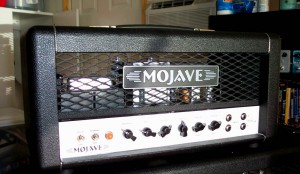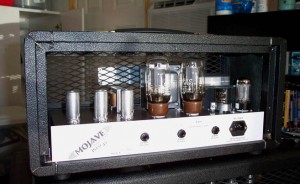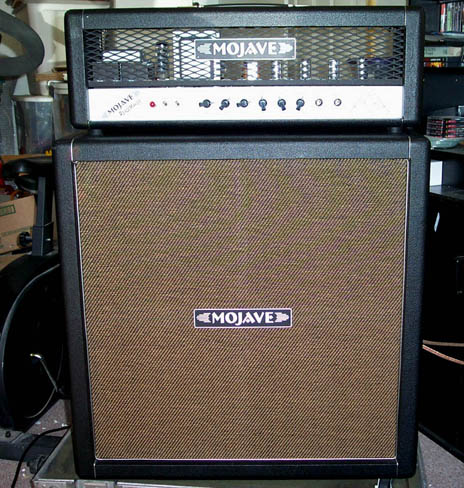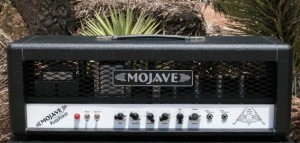Most readers at this site understand I’m a big time “amp nut” – with a special love for old Marshalls in particular. Some readers have even complained, “Too much Marshall!” in terms of content and asked me to pay attention to some other amps out there.
Well, o.k., I’m going to move away from the Marshalls, but not too far for the moment as the Mojave AmpWorks Peacemaker and Plexi 45 certainly share the Marshall heritage – in the case of the Plexi 45, its circuit is as dead-on of a true JTM 45 clone as you’ll find in any new amp built today. The Peacemaker however, adds some twists to the legendary Marshall tone, which we’ll dig into shortly.
Plexi 45 – SRP $2470.00
The Plexi 45 is made for lovers of the classic Marshall tones and was an amp used on some of the greatest recorded rock tones in history. Whether you’re talking Eric Clapton playing the blues, or Angus Young playing his own brand of energized rock and roll, these artists have and more have used the Marshall JTM 45 circuit as part of their trademark tone.
So go get yourself a Marshall JTM 45 plexi from the ‘60s and be done with it, right!?…Well, no, not exactly – the “real thing” may be the ideal solution for some of us with deep pockets (a.k.a. lots of money!) and/or a willingness to research and ensure that we’re getting something that’s not been hacked or modded – as well as pay for any needed servicing… But for the rest of us that want the JTM 45 plexi tone without the shopping headache, with unquestioned reliability, and with a full warranty – I’m just going to cut through the b.s. and tell you, Mojave’s Plexi 45 is IT!
be the ideal solution for some of us with deep pockets (a.k.a. lots of money!) and/or a willingness to research and ensure that we’re getting something that’s not been hacked or modded – as well as pay for any needed servicing… But for the rest of us that want the JTM 45 plexi tone without the shopping headache, with unquestioned reliability, and with a full warranty – I’m just going to cut through the b.s. and tell you, Mojave’s Plexi 45 is IT!
I had an opportunity to run the Plexi 45 through a pre-Rola Celestion equipped Marshall cab loaded with 25 watt greenbacks and the tone was as smooth, thick and naturally compressed as one could ever ask for. Running a Les Paul gives the results you’d expect – run the volume controls at about half way up, jumper the channels and you’ve got wonderful rock tones that aren’t buzzy, and instead are naturally warm and lightly compressed. This Plexi 45 also delivers what power tube distortion does best – dynamics. This is what makes these circuits so musical in the first place. A good player can take an amp like this and translate their feel and attack into music that is full with tonal richness and beautiful harmonics. This is sound that is missing in contemporary preamp-gain oriented amplifiers.
 Sure, you need volume to achieve this tone, but at 45 watts and without the ear-shrieking highs present in many other amps, the Plexi 45 seemed to sit perfectly in the mix when playing against the band.
Sure, you need volume to achieve this tone, but at 45 watts and without the ear-shrieking highs present in many other amps, the Plexi 45 seemed to sit perfectly in the mix when playing against the band.
Don’t mistake the Plexi 45’s warmth for having any lack of aggression. While it’s not a design made to bite your head off in treble (thank goodness for that!), there is a characteristic raw Marshall tone that’s just right in the midrange to cut through a mix and really project. I found myself playing with boost pedals to take the Plexi 45 into even more extreme lead territories and the Plexi 45 seemed to enjoy the extra push I gave it as well.
Peacemaker – SRP $2750.00
Mojave’s Peacemaker was the model I was admittedly the most curious about. The amplifiers I’ve personally played and gravitated toward most over the past few years for rock distortion have been varieties of vintage Marshall Super Leads. Essentially, the team at Mojave had the goal to take the best elements of the Marshall Super Lead tone and go with it – while at the same time looking for ways to improve and increase the tonal versatility and reliability. All of this was to be wrapped up in an amp with a build and component quality that’s generally only seen at the very high-end of the market place.
At first glance, casual users may note that the Peacemaker isn’t chocked full of external features – there are no effects loops, reverb, master volume controls or added channels. That may throw off some people until they learn and understand that the objective of the Peacemaker is to be an extension of the guitar and the player with the interaction of the power-tube distortion –  and the resulting harmonics – being the most critical element of the tone.
and the resulting harmonics – being the most critical element of the tone.
Historically, many people and companies have tried to “improve” upon the Marshall sound and usually the result was to increase the preamp gain structure and add a master volume control for a “hot-rodded” tone. This approach, while convenient for low-level bedroom noodling, always took away from the character of the great Marshall tone – the crushing harmonics, smoothness, and dynamic feel of overdriving a quad of EL34 power tubes just can’t be substituted. So with that, Mojave’s approach was to build upon the heritage of the original Marshall Super Lead and not take away from the experience of getting pure power-tube compression. The circuit is pure and the controls are minimal.
The controls that the Peacemaker does include are very straightforward – Bass, High Mid, Low Mid, Treble, and two volume controls for the two “channels” (bass and treble) which can be combined together. In addition, the chassis is beautifully detailed and nicely laid out while the head cabinet is also well designed and ventilated.
Another feature of note is Mojave’s interesting preamp structure, called “Current Tracking Technology” – four preamp tubes work together in tandem but are not run together to provide gain-on-top-of-gain (a.k.a. buzzy over compression!), but instead are working together to boost the voltages for a louder, stronger signal to hit the front end of the power tube section. With Current Tracking Technology, one of the sonic benefits I heard right away was less dramatically less “hiss” noise that you’d normally expect from a pumping Super Lead Marshall.
Now what about the actual tone? We ran the Peacemaker through a matching Mojave 4 x 12 cabinet loaded with Celestion G12H-30 speakers and plugged in a Les Paul as well as various Strats. Experienced Marshall Super Lead users should have no problem dialing in the Peacemaker. When I say “experienced”, I should qualify that by stating those who are experienced with non-master volume style amplifiers – What the potential user needs to realize is that this amp is made for performance and use in the context of a band setting. It’s a serious rock machine with a sound that can be massive and crushing or sweet and refined – but in all cases the full potential of the Peacemaker only really came to life when I used it with my band. The amount of gain on tap is on par with the early metal panel Marshalls, perhaps just a hair cleaner, but unlike those metal panelled Marshalls, the treble can be dialed out much more effectively which results in a smoother “plexi-like” tone.
I used the Peacemaker and ripped through a range of riffs with the Les Paul ranging from classic Zep and AC/DC to Van Halen  type of tones. To go into Van Halen territory, one either needs a very strong attack (and again volume is key), or some type of booster to push the front end a bit. The small 6 band MXR e.q. was what Van Halen sometimes used to push his own amps early on. At 100 watts of rated power, the Peacemaker can be a bit much in some situations such as many club environments so I recommend a THD Hot Plate to accompany the amp to tame it a bit whenever needed.
type of tones. To go into Van Halen territory, one either needs a very strong attack (and again volume is key), or some type of booster to push the front end a bit. The small 6 band MXR e.q. was what Van Halen sometimes used to push his own amps early on. At 100 watts of rated power, the Peacemaker can be a bit much in some situations such as many club environments so I recommend a THD Hot Plate to accompany the amp to tame it a bit whenever needed.
The Peacemaker also took well to the Stratocaster – with the added midrange control flexibility, I could really bring the Strat out front in the mix while also shaving off the highs as required to get rid of a lot of the “edgy” quality that Strats often have a bit too much of! The G12H30-equipped cab is a nice complement as well in assisting with this task and certainly this particular speaker is the best ceramic design that the Celestion company has produced in years.
 Surprisingly, both the high-sensitivity and low-sensitivity input channels were quite usable with all my guitars and I could get some great dynamics, feel and warmth through the low channel as well (I never liked this channel on a Marshall!). On the Peacemaker, this is where you’d plug in when you’d want a bit more warmth but still be able to retain all the gain. Great blues and classic rock tones with a bit of a rounder feel come out of this channel. Dare I suggest that I actually personally preferred the low-sensitivity channel – Maybe I’m getting old?
Surprisingly, both the high-sensitivity and low-sensitivity input channels were quite usable with all my guitars and I could get some great dynamics, feel and warmth through the low channel as well (I never liked this channel on a Marshall!). On the Peacemaker, this is where you’d plug in when you’d want a bit more warmth but still be able to retain all the gain. Great blues and classic rock tones with a bit of a rounder feel come out of this channel. Dare I suggest that I actually personally preferred the low-sensitivity channel – Maybe I’m getting old?
For the musician looking to have the experience of pure power-tube compression for a range of blues and rock tones sparked from their hands and not their feet, Mojave’s Peacemaker is a compelling choice.